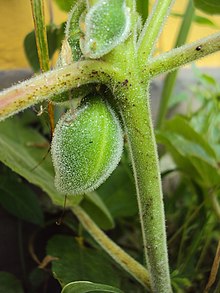| Martynia | |
|---|---|

| |
| The pendulous flowers of the plant | |
| Scientific classification | |
| Kingdom: | Plantae |
| Clade: | Tracheophytes |
| Clade: | Angiosperms |
| Clade: | Eudicots |
| Clade: | Asterids |
| Order: | Lamiales |
| Family: | Martyniaceae |
| Genus: | Martynia L. |
| Species: | M. annua |
| Binomial name | |
| Martynia annua L. | |
| Synonyms | |
| |
| This article needs additional citations for verification. Please help improve this article by adding citations to reliable sources. Unsourced material may be challenged and removed. Find sources: "Martynia" – news · newspapers · books · scholar · JSTOR (November 2017) (Learn how and when to remove this message) |
Martynia is a monotypic genus in the Martyniaceae family consisting of a single species, Martynia annua L., which is commonly known as cat's claw, tiger's claw, iceplant. or Devil's claw. However, the name 'iceplant' may also refer to members of the unrelated plant family Aizoaceae.
It is native to Mexico, Central America and the Caribbean, and has been introduced throughout the tropics. It is now quite common in rural areas of India.
Martynia is used for making beads and ornaments, and has a history of folk medicine uses in the Indian subcontinent.
Description



Martynia is an erect, somewhat shrubby annual plant about 1 metre (3.3 ft) tall, covered with glandular hairs, and has ovate, mucilaginous leaves 8–20 centimetres (3.1–7.9 in) wide and 6–19 centimetres (2.4–7.5 in) long. The leaves are opposite, and have red petioles. They resemble sticky rhubarb. Its flowers are pale pink and tubular, and have nectar guides and purple spots. Fruits become blackened when ripe and have hooked spines at the tip, lending its name "cat's claw" or "tiger's claw". They stick to animal fur and eventually the seeds fall out as the fruit gets crushed by the animal's feet.
Taxonomy
The genus and species were first described by Carl Linnaeus in his 1753 publication, Species Plantarum, although the modern taxonomic definition may not correspond with the original Linnaeus description, instead being a synonym for Proboscidea louisianica (Miller) Thellung, as well as other names used in India.
Martynia was collected by the Scottish naval surgeon William Houstoun near Veracruz, Mexico. Houstoun sent seeds of this new plant to Philip Miller, chief gardener at the Chelsea Physic Garden, in 1731. Houstoun named the plant, Martynia, in honor of a professor of botany at Cambridge, John Martyn. The plant was described in Martyn's work Historia Plantarum Rariorum, with a full description and illustration.
Martyn gave the species the following descriptive name: Martynia annua villosa et viscosa, folio subrotundo, flore magno rubro. In India, it has several taxonomic synonyms and common names.
Distribution
Martynia is widely naturalized across subtropical and tropical world regions, particularly in Central America and the Indian subcontinent. It is typically found in uncultivated fields and arable lands from plains to 1,500 metres (4,900 ft).
Uses
The plant is used for making beads and other native ornaments. It has been applied for numerous supposed treatments in Ayurveda and Siddha folk medicine.
References
- ^ "Martynia annua L." Germplasm Resources Information Network, National Plant Germplasm System, Agricultural Research Service, US Department of Agriculture. 7 March 1995. Retrieved 5 November 2017.
- Fontana, Bernard L.; Robinson, William J.; Cormack, Charles W.; Leavitt, Earnest E. (1962). Papago Indian Pottery. Seattle, Washington: University of Washington Press, on behalf of the American Ethnological Society. p. 78. OCLC 869680.
- "Martynia annua L." Kew Science, Plants of the World Online. 2017. Retrieved 29 March 2018.
- ^ "Martynia annua L." India Biodiversity Portal, Biodiversity India. 2017. Retrieved 5 November 2017.
- ^ Hevly, Richard H (1969). "Nomenclatural history and typification of Martynia and Proboscidea (Martyniaceae)". Taxon. 18 (5): 527–534. doi:10.2307/1218379. JSTOR 1218379.
External links
![]() Media related to Martynia at Wikimedia Commons
Media related to Martynia at Wikimedia Commons
![]() Data related to Martynia at Wikispecies
Data related to Martynia at Wikispecies
This Lamiales article is a stub. You can help Misplaced Pages by expanding it. |